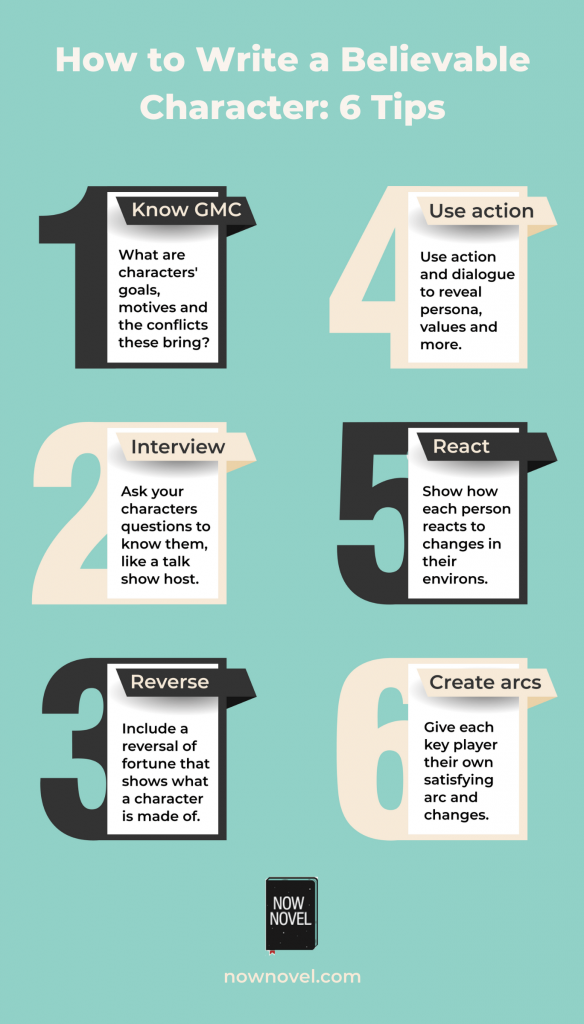Believable characters are the lifeblood of great stories. Get inspired and start creating characters readers love using these 8 tactics:
How to create believable characters:
- Do preliminary character sketches
- Ask your story’s cast of characters questions
- Give characters wants and needs (goals and motivations)
- Give characters occasional flaws and inconsistencies
- Steer clear of cultural stereotyping
- Allow characters to change over time
- Give each character a distinct voice and personality
- Learn how to create believable characters from great authors
Let’s look at each of these parts of the character creation process closer:
1: Do preliminary character sketches
A detailed sketch of your characters’ histories will help you create believable characters. Character sketches are a form of outlining. Instead of outlining the entire plot, you finish story sketches to begin. For each character, write down their:
- Your character’s name, age, and gender
- Relation to the cast of characters (e.g. ‘mother of the protagonist’)
- Possible story purpose (e.g. ‘confidant of the protagonist; helps him overcome primary challenge’)
- Backstory (pivotal life events, fears, secrets and hopes)
- Greatest strength and greatest flaw
These are just some examples. The ‘Character’ section of Now Novel’s idea finder (a series of guided prompts) gets into more detail than this.
Set yourself a definite end date for completing your sketches so you can draft your novel.
2: Ask your cast of novel characters questions
To write more believable characters, do character interviews.
Set each of your created characters a series of questions, such as:
- What was your proudest moment?
- What was your most embarrassing experience?
- Who is your personal idol and why?
- If your house was on fire, what’s the first thing you’d save?
- What do you crave most in life?

Be creative and personal. The aim is to know your characters inside out, so that you believe in their private histories, emotions and psychologies.
This will help you create unique, individual character profiles.
3: Give characters wants and needs (goals and motivations)
Kurt Vonnegut famously said that every character in a story should want something, even if it’s only a glass of water.
This is excellent advice for creating believable characters. Characters who have goals and motivations are believable because they (like us) have desires. They don’t simply sleepwalk through your novel.
Think of the primary motivations that drive people. They include desire for:
- Love or intimate relationships
- Wealth, fame and/or status
- Redemption or restored dignity
- A better world or the happiness of others
These are just some character motivation examples.
Characters are especially believable when you show why they hold these desires. For example, a character obsessed with wealth and status might have endured struggle and disadvantage. The famous author Charles Dickens, for example, was sent to work in a blacking factory as a child and the spectre of this experience haunts his novels.
Make sure characters’ wants or goals align with their motivations. A character whose goal is romance might crave external validation.
Each goal and motivation comes with its own challenges. These challenges add tension and internal obstacles to your character’s story path.

Develop better characters
Develop your characters with easy, step-by-step prompts and feedback.
LEARN MORE4: Give characters occasional flaws and inconsistencies
Characters who always say and do the right thing are usually boring. Even superheroes who have astounding powers have weaknesses – for a good story, your Superman has to have his kryptonite. Finishing a book without your characters having confronted vital change can make it seem flat.
Character flaws are useful because:
- Flaws are relatable – most people can admit they have their own internal challenges (e.g. having a quick temper)
- Flaws create internal conflict that adds dramatic tension to your story (e.g. Will the character overcome her quick temper when it matters most?)
- Different characters’ flaws and how they play (or don’t play) together create drama and intrigue
Your characters don’t have to be consistent with their personal beliefs, values or goals all the time. A character who is conservative could have a wild fling with a practical stranger that is ‘out of character’.
For out of character incidents in your novel, make sure you show the underlying cause of your character’s unexpected actions. This way, readers are less likely to say ‘I don’t believe the character would do that’.
5: Steer clear of cultural stereotyping
The most widely criticized type of character in fiction is the stereotype of a nationality, ethnicity or cultural identity. Be careful of representing ‘foreign’ accents using alternate spellings. Make sure that your novel’s ‘others’ are not mere props. There is a thin line between cultural appreciation and appropriation.
To ensure that your characters don’t come across as stereotypes, run your draft past beta readers who are members of the culture or subculture you want to depict.

6: Make characters change over time
Even if your story or novel takes place over a single day, change in your characters’ outlook and/or goals is important.
Events in your story should impact your characters in a believable way, affecting their decisions and viewpoints. Read this guide to character development for tips on how to craft characters’ individual journeys.
7: Give each character a distinct voice and personality
Creating believable characters means giving each character in your novel a distinct voice and personality. Parts of a character’s voice include:
- Accent, diction and favourite sayings
- Tone and register (e.g. gruff, high-pitched, formal and eloquent or informal/casual)
- Movement (variation in pitch or monotone)
While making each character’s voice unique, avoid being over the top. An eccentric character might use quirky sayings. Aim for balance. Give that eccentric character their straight-laced counterpart. Contrasts between characters make the entire cast easier to believe.
Besides a distinct voice, each character should have a personality. A good example of personality differentiation is Louisa May Alcott’s novel Little Women (1868). In Alcott’s novel, she gives each of the four March sisters (Margaret, Josephine, Elizabeth and Amy) a strikingly different persona.
In Little Women, the eldest daughter Margaret or Meg is the ‘good daughter’ and looks after the others when her parents are away. Josephine or ‘Jo’, by contrast, is creative, strong and willful, and is less accepting of gender expectations than her elder sister. The third sister, Beth, is gentle, musical and introspective while the youngest sister Amy is vain and materialistic.
Giving each character distinguishing traits will help your characters ring true.
8: Learn how to create believable characters from great authors
To learn how to create believable characters, start keeping a journal devoted to characterization. Note how your favourite authors introduce characters and flesh them out. Also jot down any significant ways characters’ behaviour confounds expectations.
Part of writing believable characters is also mastering character description. Use physical description, dialogue and action together because balanced description helps readers build vivid mental imagery.
Ready to create character sketches? Develop your story outline online now using Now Novel’s easy outlining tools.


5 replies on “How to create a believable character: 8 tactics”
[…] Modern-day novel writing | How to create believable characters […]
thanks
This is an amazing insight. Could you suggest any books about creating a character as an actor?
Thank you, Cathrine. Do you mean creating a character who is an actor, or creating a character as an actor in the sense of how to play a character? We do have an eBook book on creating detailed characters if the former which you can find here.
[…] characters. Maybe your character puts ketchup on his eggs, or she constantly forgets her wallet. Quirks and foibles will make your characters more relatable and maybe even a little […]